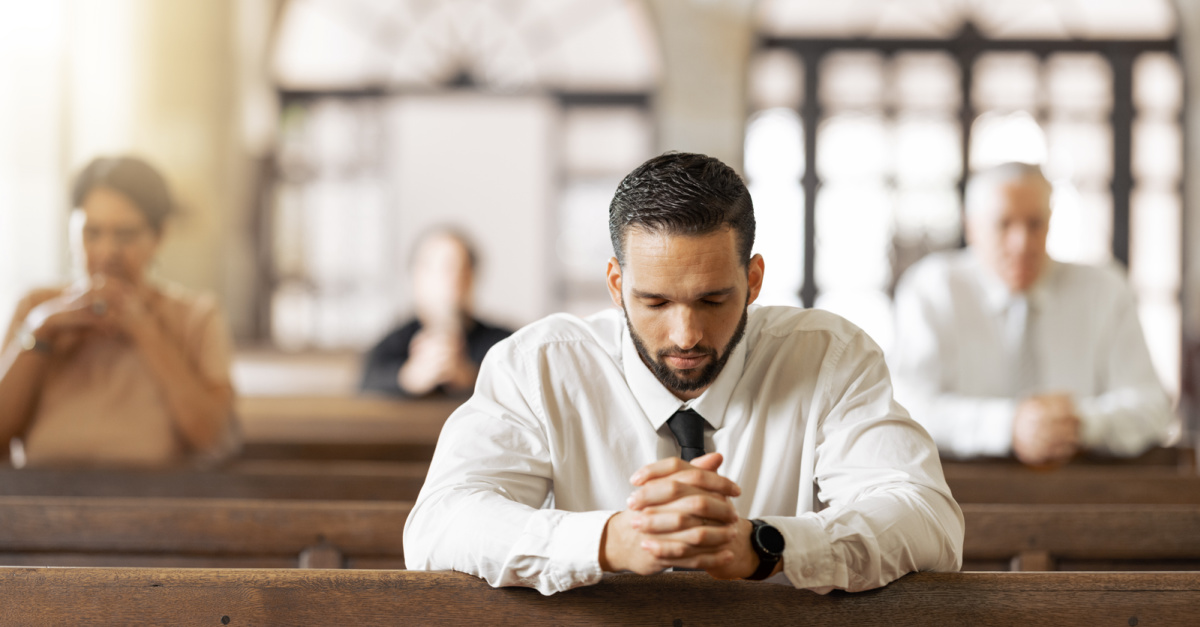
Research confirms that women tend to be more religious than men. Why is this the case? There are many working theories on an answer to this question. I think we might be served by reframing our thinking on this issue.
A Pew Research study in 2018 confirmed what we’ve all assumed for many years—women tend to be more religious than men. This isn’t true of only Christianity. Nor is this only true in the US. However, it seems to be more prominent here in the US. This is what Pew found:
More than seven-in-ten U.S. Christian women (72%) say religion is “very important” in their lives, compared with 62% of the country’s Christian men, according to Pew Research Center’s 2014 U.S. Religious Landscape Study. Roughly eight-in-ten Christian women also say they are absolutely certain God exists and that the Bible is the word of God, compared with about seven-in-ten men who say this.
Christian men and women in the U.S. also differ in their private devotional habits. For example, roughly three-quarters (74%) of Christian women say they pray at least daily, compared with six-in-ten men (60%). The gender gap in prayer is especially wide for Catholics and mainline Protestants: 67% of Catholic women say they pray every day while just 49% of men say the same. And 62% of mainline Protestant women say they pray daily, compared with 44% of men. Among the U.S. Christian traditions analyzed in this study, Mormons are the only group in which there is no prayer gender gap, with similar shares of women and men saying they pray daily (86% and 84%, respectively).
Why is this the case? There are many working theories on an answer to this question. I think we might be served by reframing our thinking on this issue.
A Few Common Theories
Statistics tell us the cold, hard facts. But the devil is in the details. Or rather, the devil is in us debating about the questions that come to us after statistics. Here, we find ourselves asking, “Why?” Why are more women than men in our churches? There are about as many answers as there are people. But they usually center around a few themes.
Some point to simple biology. They note that these statistics often cross cultures and even religious traditions; perhaps there is something biologically present in women where they seek a connection to the divine. Maybe spirituality and religious practices just resonate more with the feminine psyche.
Many will point to socialization and gender roles. From an early age, boys are trained towards certain behaviors, and girls are trained towards others. Religious participation is traditionally associated with nurturing and communal values, things which have historically been associated with the fairer sex (as evidenced by the way I worded that). It is thought that more women than men will pursue the support and communal environment that religious communities often provide. Why do more women go to church? Simple, they are socially trained to attend to religious matters.
In a similar vein, we might consider how men are trained to not do these things. The vulnerability often associated with church goes against the rough and rugged persona men are expected to embrace. Real men don’t cry. And there can be plenty of crying in church. Men don’t go to church because it is perceived as a womanly thing.
Even the church's own “marketing” doesn’t do it any favors. What self-respecting dude wants to refer to himself as the “bride of Christ”? And if the worship songs are basically love songs to a Galilean carpenter—why would we be surprised when men don’t want to show up? Add the floral arrangements, the pastel colors, and other aspects create a feminine setting, so a “manly man” doesn’t stand a chance in your local church.
Another theory has to do with our history. We began as an agrarian society. Many men weren’t able to attend a service on a Sunday morning. Many had to work. As their work took them more and more away from religious community it became entrenched within our society. Men don’t go to church because their dad didn’t go to church, and their dad didn’t go to church, on and on for a few generations. Combine this with some of the above theories, and you might have a solid answer—why would a man take off from a time for hard work only to attend a hug-fest, sing romantic music, and then hear a droning sermon?
The solution which many propose is to make your church more intentionally masculine. Write sermons that appeal to men. Have events that appeal to the more rugged among us. Give challenges and adventure and all those things that appeal to men. Take out the floral arrangements and try centering a deer head.
But I wonder if maybe we’re asking the wrong question here.

Photo Credit: ©Getty Images/People Images
A Working Theory, or a Path Forward
Let’s take that “church is too weak and feminine” theory for a test drive. It’s thought that men want a challenge, they want some danger, some adventure. (You can insert that famed Tim Allen grunt here). If we’d make church a little bloodier and a bit less tender, then we’d find more men gracing our pews… or at least pacing in the back with a sword or something.
But let’s take a little journey to the bloodiest, darkest, and most dangerous moment in the history of the church. Or rather, the most decidedly “masculine” moment in the history of the universe. The story in which all other stories of rescue and such find their inspiration. It’s the story of a bleeding man upon a cruel Roman cross. A man who was so dedicated to rescuing others that He was willing to die in their place. A moment of great heroism. But a moment of great barbarity.
Take a look at the foot of the cross. Who do you see? In this darkest hour—when danger is at its peak for a Jesus follower—where are these men who have been following him? Many aren’t even present. His right-hand man, that burly fisherman, is cowering in the distance. In fact, men are outnumbered there at least 4 to 1.
My point here is that when it was the MOST dangerous and challenging and ruddy to follow Jesus, the men weren’t there. Maybe more women are in church because they are stronger than us men in a different way. Not physically, but they have the capacity to hang in there and do hard stuff (See childbirth). They will suffer and endure for/with others in a way that we men struggle with. In other words, maybe it’s not that church isn’t challenging enough but that it’s too challenging.
I’m not talking here about merely attending a service. If that’s the whole of your Christianity, it’s not following in the footsteps of Jesus, and that’s true if you’re male or female. I’m talking here about the church community. And that is difficult in a way that I believe chisels away at an area where we men might be particularly impacted by the fall.
I think, then, there might be some truth to some of those earlier theories. It is probably a reality that it takes less redemption for a woman to do churchy things. In other words, generally speaking, the very nature of the church community might appeal to a female—even apart from redemption. The fall, I would argue, has impacted women differently than men.
I’m saying this because I believe it is an entirely silly and wrong-headed notion to appeal to the fallen sensibilities of men in order to get them into church. All we’re doing is recreating a community that doesn’t require redemption to be part of (or to be appealing). It’s just creating a barrier for one sex by making it perhaps easier for another.
I’m speaking broadly here, but perhaps this drive for community, self-sacrifice for the flourishing of others, etc., that we so often see in the ladies within our church, is where we fellas need to see the image of God. It is precisely here where we need to be challenged. These aren’t feminine qualities—they are human qualities. But human qualities where we might see the imago Dei shining a bit more brightly in women.
Perhaps, rather than asking why men aren’t going to church, or what can we do to get them through the door, or how do we keep them… maybe we should ask, “Why are women going to church” and be challenged.
Conclusion
Interestingly, a recent study found that the gender gap is shrinking among Generation Z. In fact, it might be flip-flopping. Women are becoming less religious than men. Sadly, this isn’t because men are becoming more religious—it’s simply that the unbelief among women has caught up with us. It would require another article to explore the reasons for this. I mention it here only to say that I think it proves my point.
When we ask the wrong questions, we come up with the wrong solutions. I fear when confronted with statistics, and our own anecdotal observations, we tend to engage in shuffling junk around. My family just moved from one house to another. As we unpack, there are times it feels like our cleaning up of one room is only moving a pile of stuff into another room. To me, those statistics about Gen Z only confirm that we’re shuffling junk piles—and ending up with a net loss.
The answer to this question about men going to church, and women going to church for that matter, is found in the gospel. Redemption is what will get people connected to other believers. As we are in union with Christ, we’ll pursue community. As we do this, we’ll find that we’re shaped into more Christlikeness not by pursuing people who look and think just like we do, but rather, we’ll be hungry to see the entirety of the image of God. And that will mean that our churches aren’t decidedly masculine or feminine. They just look like Jesus.
Photo Credit: ©GettyImages/DedMityay
Mike Leake is husband to Nikki and father to Isaiah and Hannah. He is also the lead pastor at Calvary of Neosho, MO. Mike is the author of Torn to Heal and Jesus Is All You Need. His writing home is http://mikeleake.net and you can connect with him on Twitter @mikeleake. Mike has a new writing project at Proverbs4Today.







